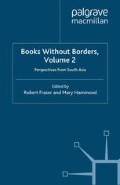Abstract
Writing in the early twentieth century, Saralabala Sarkar recalls her childhood experience of listening to popular religious tales:
A flood of affection and sweet lament inundated us during the scene when Yashoda dresses the young Krishna prior to sending him into the forest. … At other times the kathak (narrator) would … describe the sacrificial scene of King Daksha with such tremendous ferocity and intensity that children in the audience would become fearful. … During scenes describing the marriage of Sita, the kathak would be honoured with vermilion and conch-shell bangles (the marks of the Bengali married woman) … it was as if he had become everyone’s very own.1
Access this chapter
Tax calculation will be finalised at checkout
Purchases are for personal use only
Preview
Unable to display preview. Download preview PDF.
Notes
Robert Darnton, ‘History of reading’ in Peter Burke (ed.), New Perspectives on Historical Writing (Cambridge: Polity, 1991)
Paul Saenger, Space Between Words: The Origins of Silent Reading (Stanford: Stanford University Press, 1997)
Lisa Jardine and Anthony Grafton, ‘“Studied for action”: How Gabriel Harvey read his Livy’, Past and Present, 129 (November, 1990), pp. 30–78
Alberto Manguel, A History of Reading (London: Harper Collins, 1996)
James Raven, Helen Small and Naomi Tadmor (eds), The Practice and Representation of Reading in England (Cambridge and NY: Cambridge University Press, 1996)
Roger Chartier, ‘Reading matter and “popular” reading’, p. 273. See also, B. W. Ife, Reading and Fiction in Golden-Age Spain: A Platonist Critique and some Picaresque Replies (Cambridge and NY: Cambridge University Press, 1985).
Adrian Johns, The Nature of the Book: Print and Knowledge in the Making (Chicago and London: University of Chicago Press, 1998).
Stuart Blackburn and Vasudha Dalmia (eds), India’s Literary History: Essays on the Nineteenth Century (New Delhi: Permanent Black, 2004).
Even Priya Joshi’s otherwise meticulous study of readers and literary consumption of English novels in India takes silent reading as the basic premise. See Priya Joshi, In Another Country: Colonialism, Culture and the English Novel in India (New York: Columbia University Press, 2002).
Roger Chartier, Cultural Uses of Print in Early Modern France, trans. Lydia G. Cochrane (Princeton, New Jersey: Princeton University Press, 1987), p. 7.
Even though literacy is not adequately reported in official Indian records during this period, a significant portion of the population had an elementary knowledge of reading and writing. See the outstanding study by Parames Acharya, Banglar Deshaja Sikshadhara (Calcutta: Anushtup Prakashani, 1989).
Edward Ives, A Voyage From England to India (London, 1773), p. 29; Q. Craufurd, Sketches Chiefly Relating to the History, Religion, Learning and Manners of the Hindoos with Concise Accounts of the Present States of the Native Powers of Hindostan (London: T. Cadells, 1792), vol. 2, pp. 12–13
William Ward, A View of the History, Literature and Mythology of the Hindoos, 4 vols, 3rd ed. (London: Black, Parbury, and Allen, 1817–20), vol. 3, p. 160
William Adam’s earliest surveys produced three invaluable reports between 1835 and 1838, reprinted in Anathnath Basu (ed.), Reports on the State of Education in Bengal (Calcutta: Calcutta University, 1941).
Dinesh Chandra Sen, History of Bengali Language and Literature (Calcutta: Calcutta University, 1911), p. 599.
Cited in P. Heehs (ed.), Indian Religions: A Historical Reader of Spiritual Expression and Experience (London: Hurst, 2002), p. 194.
This phenomenon has been studied in detail by historians. See e.g., Aparna Basu, The Growth of Education and Political Development in India, 1898–1920 (New Delhi: Oxford University Press, 1974).
For a fuller discussion of this see Anindita Ghosh, ‘Between the Text and Reader: The Experience of Christian Missionaries in Bengal (1800–1850)’, in James Raven (ed.), Free Print and Non-Commercial Publishing Since 1700 (Aldershot: Ashgate Press, 2000), pp. 162–76.
Bepin Pal, Memories of My Life and Times, 1857–1884, 2 vols (Calcutta: Sanyal & Co., 1932), vol. 1, p. 85.
Author information
Authors and Affiliations
Editor information
Editors and Affiliations
Copyright information
© 2008 Anindita Ghosh
About this chapter
Cite this chapter
Ghosh, A. (2008). The Many Worlds of the Vernacular Book: Performance, Literacy and Print in Colonial Bengal. In: Fraser, R., Hammond, M. (eds) Books Without Borders, Volume 2. Palgrave Macmillan, London. https://doi.org/10.1057/9780230289130_3
Download citation
DOI: https://doi.org/10.1057/9780230289130_3
Publisher Name: Palgrave Macmillan, London
Print ISBN: 978-1-349-30290-1
Online ISBN: 978-0-230-28913-0
eBook Packages: Palgrave Literature & Performing Arts CollectionLiterature, Cultural and Media Studies (R0)

